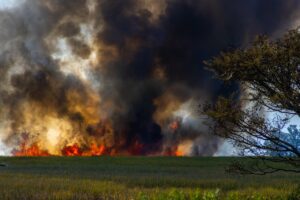
By Toby Rock. Bay City News.
Researchers at San Jose State University say they used artificial intelligence in a recently published study, using AI to link rising temperatures due to climate change and the daily behavior of California wildfires.
The study, published Wednesday in the journal Nature, departs from previous research on the California wildfires that examined the impact of climate change on broad measures of fire activity, such as the total area burned over large regions and entire years. .
It revealed that the impact of climate change on historic fires is not uniform. Instead, their influence varies across individual fires and specific days, depending on whether rising temperatures and arid conditions cross critical thresholds.
In some cases, climate change has a minimal effect, while in others it increases the risk of extreme daily fire growth (over 10,000 acres in one day) by more than five times.
The research also showed that strict reductions in emissions, reaching net zero by the 2070s, would result in a 21 percent increase in extreme wildfire days by the end of the century compared to today.
Conversely, if conditions continue to rise through mid-century, without reaching net zero by 2100, the increase would more than double, reaching 45 percent.
The researchers said these findings highlight the importance of reducing emissions and the need for strategies like better forest management to control risk.
They added that implications of the study regarding critical thresholds that trigger extreme wildfire behavior could guide practical decisions to mitigate fire risk, while insights into optimal times and locations for fuel management can inform forest fire prevention strategies.
“Using this method, we have developed an operational wildfire intensity forecast that should help inform decisions by fire management agencies, as well as any group trying to minimize wildfire risk exposure,” he said in a statement. said study co-author Craig Clements.
The authors of the research said that the use of AI allowed them to determine the relationship between temperature and wildfire behavior directly from the data, removing any preconceived notions and enabling a new understanding of how temperature influences activity. of the fires.
The AI model used in the study is now operational and available on the SJSU website at http://www.met.sjsu.edu/weather/wirc-prod/.
"We were able to assess the impact of climate change on the daily behavior of individual historical fires without addressing the problem with built-in assumptions about what we think that relationship should be," study lead author Patrick Brown said in a statement. .
Brown is co-director of the Oakland-based Breakthrough Institute's Climate and Energy Team, a visiting research professor at SJSU, and a member of the university's Wildfire Interdisciplinary Research Center.
Brown worked alongside Clements, director of the Wildfire Interdisciplinary Research Center, as well as fellow Adam Kochanski and SJSU alumnus Holt Hanley, with additional co-authors from UC Berkeley, UC Irvine, and PG&E's Fire Science and Meteorology group. .
You may be interested in: Learn how to spot phishing scams and what to do if you fall victim


